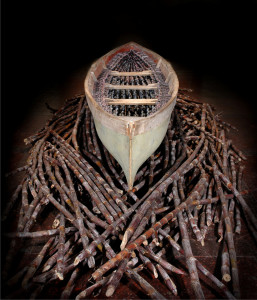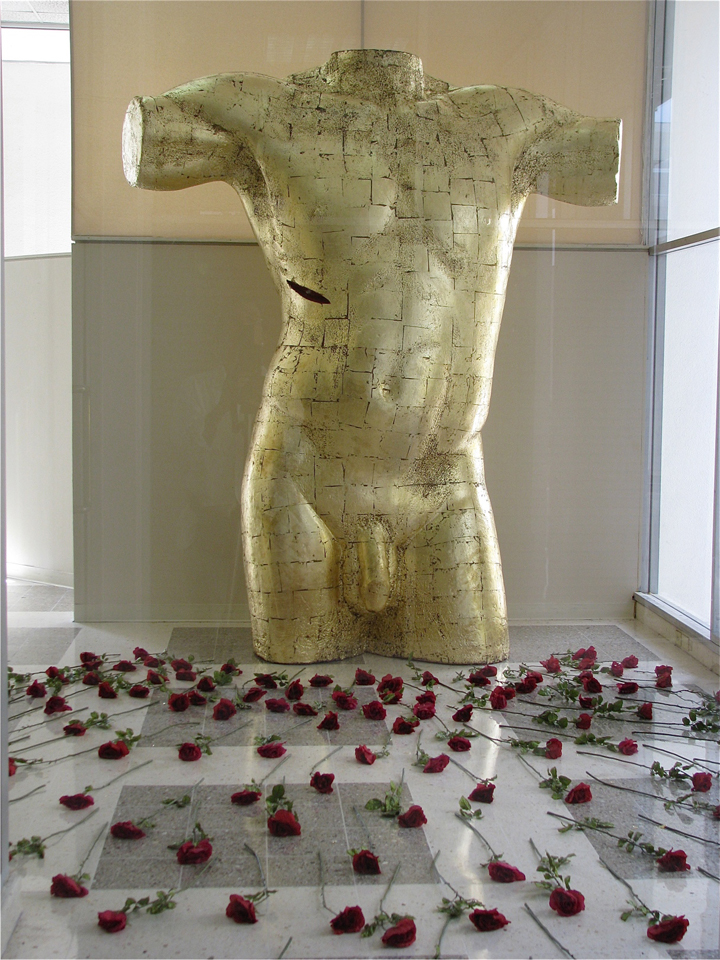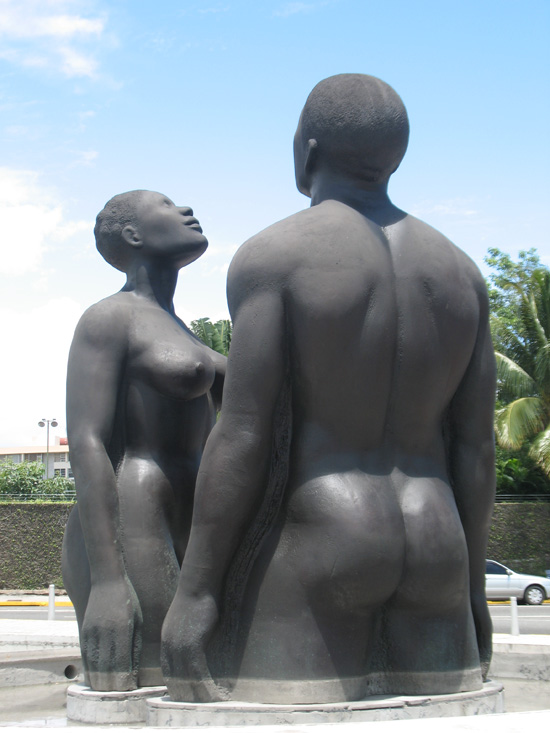
Laura Facey is one of the artists in:
THEIR SPIRITS
INTERNATIONAL SLAVERY MUSEUM, LIVERPOOL
Until September 7, 2014.
Their spirits gone before them, 2006, copyright Donnette Zacca.
Their Spirits by Jamaican artist Laura Facey Cooper is on view at the International Museum on Slavery
(out of ‘Uprising, Contemporary Caribbean Art’)
This exhibition by the acclaimed Jamaican artist Laura Facey explores not only the indescribable cruelty of slavery but also the transcendent nature of the human spirit, through a number of artworks.
At the heart of the exhibition is Their Spirits Gone Before Them, 2006; a cottonwood canoe, floating on dried sugar cane. Inside the canoe are 1,357 resin miniatures of ‘Redemption Song’, a monument which stands at the ceremonial entrance to Emancipation Park in Kingston, Jamaica. It was previously exhibited at the World Bank in Washington DC.
This canoe represents two journeys: one was made by the millions of Africans who were enslaved and taken from their homeland during the transatlantic slave trade and the other is Laura Facey’s own personal transformation in creating the piece. Laura’s inspiration came when she was asked to create souvenir miniatures of the ‘Redemption Song’ monument:
« I began to ‘see’ my miniatures in a canoe and a struggle began inside me: How can I take my healed Redemption Song figures and place them in a slave ship? »
Laura went in search of the perfect vessel. In Jamaica, fishermen hollow out canoes from giant cottonwood trees; her miniature figures, each of them representing approximately nine hundred enslaved Africans who were transported to Jamaica, were installed; the canoe was set on a sea of sugar cane and Their Spirits Gone Before Them emerged.
For this journey the iconic slave ship has been transformed and while it acknowledges the grim reality of the enslaved Africans, « It’s not about ropes, chains or torture » but rather, it is a « sculpture that communicates transcendence, reverence, strength and unity. »
Laura Facey also said: “In one moment the viewer of Their Spirits can experience the history and memory of slavery. The canoe sits on a sea of sugar cane – a commodity at the centre of the trade in enslaved Africans. The men and women in the symbolic canoe are enslaved yet they stand with dignity – upright and facing each other. Visitors, if they’re familiar with Bob Marley’s Redemption Song, may hear the words: ‘None but ourselves can free our mind’. The work indicates a way to go forward with a freed sense of spirit.
As well as the canoe installation, Their Spirits will also contain a number of other artworks by Laura Facey. This will include nine prints and other sculptures.
News and commentary on Caribbean culture, literature, and the arts
ivetteromero | September 29, 2013
A Touch of Jamaican Healing with “Radiant Earth” Artist Laura Facey
Lisa Anderson (Parlour Magazine) interviews Jamaican artist Laura Facey, whose exhibition “Radiant Earth” (curated by Melinda Brown) opened at The Princes School of Traditional Arts in London this week and runs until October 4 2013. Anderson writes:
After the British Museum’s landmark acquisition of her work in 2012, award-winning Jamaican artist Laura Facey is back in the UK for her first London solo exhibition. Entitled Radiant Earth, the show promises a retrospective of the work that followed her controversial 2002 Redemption Song monument to Jamaica’s emancipation. “Their Spirits Gone Before Them” – a cottonwood canoe filled with 1,357 resin miniature figures, features at the heart of the exhibition, echoing the reverence for nature and faith in the power of transformation evident in Redemption Song and later works. During her final preparations, Parlour caught up with Facey and her curator Melinda Brown to uncover more.
Where did the idea for Radiant Earth idea come and how does it relate to your work?
Melinda Brown: When we first met in late 2005, she had recently overcome serious illness and had turned her focus away from human bodies, often tortured bodies towards her immediate physical environment on the farm in rural St.Ann, Jamaica where she lives and works. The first exhibition I curated for her in 2006 called “The Everything Doors” featured portraits of plants and other botanical specimens. This change heralded the beginning of a whole new body of work and the genesis of the Radiant Earth concept, reflecting Laura’s powerful connection to the earth around her.
Laura Facey: Everything radiated out from that process of healing.
Tell us about your creative process, what ideas inform your work and what turns you on?
LF: I like to work with idea of tools as metaphors within my work. For instance a comb untangles, a needle stitches together, a plum bob finds the centre, a ladder takes you upward. Just as I had to untangle my life, stitch it back together and move to another level of consciousness, my artworks are the metaphors that I now present to the world for the healing of the planet – if it was that easy. In fact the idea of healing turns me on – healing the people and the earth around me. That’s my mission, really.
MB: Laura’s also a great swimmer so there’s this magnificent turquoise swimming hole on her farm, but to reach it you have to go down a very steep path that’s a about a kilometre into a deep ravine. On a daily basis, Laura goes down to this water and swims against a gushing current and then runs back to the top of the hill, which would knock most people out, but she starts her day in this way. Jamaica’s great like that, in its own way it is physically healing. [. . .]
What do you think of the upcoming crop of Jamaican artists? Do you have any favourites?
LF: I adore the work of Ebony G. Patterson, especially her early work. Her two-toned faces, her palms and intricate backdrops. I also love her glittery installations as a reflection of dancehall culture; they attract me. I think she’s very dynamic. Charles Campbell’s work is also beautiful and I really like an artist called Sand, who has produced amazingly imaginative drawings, with beautiful lines and imagery. [. . .]
For more information on Laura Facey, see her artist’s page at LauraFacey.com
For full interview, see http://parlourmagazine.com/2013/09/a-touch-of-jamaican-healing-with-radiant-earth-artist-laura-facey/





